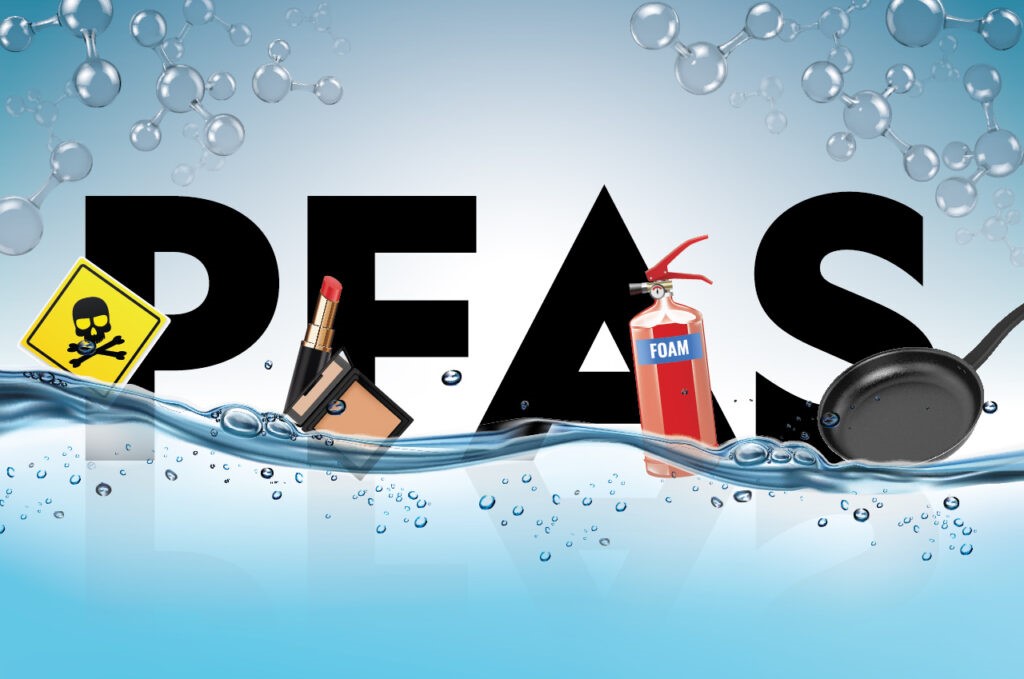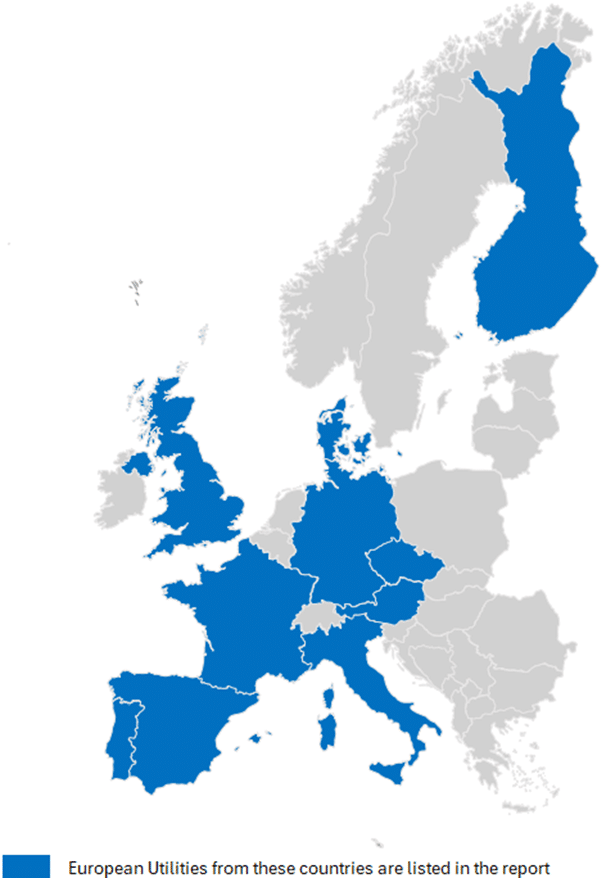The recently proposed EPA regulations to limit per- and polyfluoroalkyl substances (PFAS), the forever chemicals, in drinking water provide unique and timely investment opportunities for several select water treatment suppliers and publicly traded water utilities. PFAS has become an increasingly significant environmental and public health concern due to their persistence and inability to naturally degrade. To meet the proposed regulation of 4 parts per trillion (ppt), the nation’s water and wastewater utilities will require roughly $50 billion of capital investment over the next 3-5 years and an additional $1-2 billion of annual operating expense.
A strict enforcement of the regulation would likely lead to increased demand for treatment equipment and capacity restraints on the available engineers, contractors, and suppliers to build the required treatment. We expect the suppliers of the three recognized effective treatment technologies (activated carbon, anion exchange, and membrane filtration) to be beneficiaries given the significant increase in demand. We also expect the nation’s water utilities to benefit from the enhanced rate base growth and increased acquisition opportunities.
PFAS are a large group of environmentally persistent, man-made chemicals used in industrial and commercial applications including firefighting activities, stain repellents, and non-stick cookware, among others. Currently there are over 600 PFAS compounds which are EPA-approved for sale or import into the United States. These molecules, with a chain of linked carbon and fluorine atoms, are valued for their high resistance to oil, water and heat. Due to their widespread use, PFAS are being found at low, ambient levels in the environment. Perfluorooctanoic acid, or PFOA, and perfluorooctane sulfonic acid, or PFOS, are two of the PFAS often found in drinking water. They are legacy compounds, phased out or no longer manufactured in the U.S. and Europe, but which are still present in the environment. The presence of PFAS compounds in several water sources, including drinking water, is of increasing public concern due to their environmental persistence, and perceived health concerns. As per the National Center for Biotechnology Information, PFOAs have been detected in the blood of more than 98% of the U.S. population. Research shows that they increase cholesterol level, affect the immune system, and increase risks of certain cancers such as kidney and testicular. PFAS contaminates groundwater through various pathways such as industrial discharges, firefighting foams, landfills and waste sites, farmlands, and accidental spills (Exhibit 1). Most PFAS concentration is found in the environment around military bases, firefighting training locations, commercial airports, and former manufacturing facilities where they seeped into the local water supplies. The above occurs due to leakage, irresponsible disposition of waste, products dumped into rivers, and/or their presence in firefighting foams, which either seep into the ground, or are carried to surface water by rains.
Exhibit 1 PFAS Groundwater Contamination Pathways

Source: Bluetoad.com
Uses of PFAS and Their Derivatives
The first PFAS were invented in the 1930s as the main ingredients in nonstick and waterproof coatings according to the Interstate Technology & Regulatory Council; they were initially used to protect military equipment from damage by the environment. The development of these chemicals increased in the late 1960s after a deadly fire aboard a US Navy aircraft carrier, the USS Forrestal in 1967. Soon after the accident, manufacturers and scientists developed PFAS-containing aqueous film-forming foam (AFFF); a mixture that rapidly extinguishes fires and is highly effective against petroleum fires and other flammable-liquid fires when mixed with water. PFAS-containing AFFF was subsequently installed on military and civilian ships, airplanes, and airports.
The compounds have wide-ranging applications and are highly utilized due to their ability to repel oil and water. They are found in many products such as the following, among others:
· Teflon non-stick cookware
· Carpeting as stain-resistant
· Upholstery
· Leather
· Paints
· Paper & packaging (food packaging such as pizza boxes)
· Apparel/textiles (weather repellent; waterproof clothing)
· Floor wax
· Firefighting foams
· Sealants
· Chrome plating/electronics manufacturing/oil recovery
Exhibit 2 Common Items Containing PFAS

Source: Earthjustice
On March 14, 2023, the EPA issued its long-awaited national standard for PFAS in drinking water. The proposed regulation would establish 4 parts per trillion (ppt) as the legally enforceable level for PFOA and PFOS. Notably, 4 ppt is the lowest level that current technology can detect. In addition, four other PFAS will be regulated as a mixture. After a public comment period, a final rule is expected to be issued in late ’23 or early ’24. If adopted as is, water providers/utilities would need to comply with the final regulation within three years of the date of adoption (implying by the end of 2026).
How Much Will it Cost?
The American Water Works Associations (AWWA) estimates national cost to install treatment facilities and processes to remove PFOA and PFOS to EPA’s proposed levels exceeds $47 billion, which is approximately $35 billion above what would be required to meet current state established PFAS limits (Black & Veatch study). Further, it will require more than $700 million annually for operations and maintenance costs to test and monitor for compliance, which is $500 million more than what would be required to meet current state-established PFAS limits. These dollar values are significantly higher than EPA’s cost estimates. The cost of compliance (capital and operating costs) will be very specific to each system and is likely to be significant for some areas of the country.
· American Water Works (AWK), the nation’s largest publicly-traded water utility, initially estimates over $1 billion of capital investment to install additional treatment facilities over a 3 to 5-year period and $50 million of annual operating expenses related to testing and treatment. The company believes that more than 100 of its existing drinking water treatment facilities will need to be upgraded to provide PFAS removal capability. AWK’s operating utilities in most of its states are currently plaintiffs in the Multi-District Litigation against multiple PFAS manufacturers and believe that the ultimate responsibility for the cleanup of these contaminants should fall to those who created the problem.
· SJW Corp (SJW) has initially estimated that PFAS compliance would cost $170-190 million over the next 3-5 years, including $120 million in Connecticut and $50-70 million in California.
· Essential Utilities (WTRG) has not yet disclosed an estimate but has been an early-mover to address the issue. In 2020, WTRG set internal target of 13 parts per trillion for multiple PFAS chemicals compared to EPA health advisory level of 70 parts per trillion. In 2021, the company completed a state-of-the-art environmental laboratory, to test for PFAS chemicals in Pennsylvania, and advanced a litigation strategy to force the polluters to pay the cleanup costs. WTRG expects to complete mitigation by 2027.
How to Fund Capital and Ongoing Operating Expense?
We expect the nation’s water utilities to fund the capital and operating expense through a combination of federal and state money, lawsuit settlements, and increases in customers’ rates. The National Association of Water Companies (NAWC) advocates that the EPA and other policy makers hold polluters accountable, exempt all water and wastewater systems from PFAS financial liability, ensure compliance by all water utilities – whether privately or municipally owned, and allow access by all to federal and state funding. Without a legal settlement, the significant costs of complying with that regulation would be borne entirely by customers. Further, we expect that states and state public utility commissions (PUCs) will treat these expenditures for regulated utilities as federally mandated requirements that are recoverable in customer rates through expedited means.
The 2021 Infrastructure and Jobs Act made $10 billion available to help municipal utilities address emerging contaminants, but the amount is insignificant relative to the huge capital necessary to address the nation’s capital needs. The NAWC is calling on Congress and the EPA to enact laws and regulations to ensure that those who manufactured and used PFAS chemicals are responsible for funding cleanup and treatment and protect water and wastewater customers from having to fund further cleanup efforts
Forever Chemicals’ Manufacturers Reach $1.2B Settlement with Water Utilities
On June 2, 2023, it was announced that DuPont (DD) and spin-offs Chemours (CC) and Corteva (CTVA) reached a comprehensive settlement in principle of $1.185 billion to resolve PFAS claims with respect to U.S. water systems over the contamination of drinking water supplies. Under the agreement, Chemours will pay $592 million, DuPont around $400 million, and Corteva $193 million to resolve the claims related to public water systems that serve the vast majority of the U.S. population and would cover an estimated 88% of water utilities. However, the $1.185 billion proposed would cover less than two years of the projected costs of complying with EPA’s proposed drinking water regulation, which the EPA estimates would cost utilities $772 million annually. NAWC believes this is a step in the right direction and will continue to monitor the ongoing discussions around PFAS.
On the same day, Bloomberg reported that 3M (MMM) is nearing a deal to pay nearly $10 billion in a settlement for PFAS related pollution and avoid a federal trial for its part in the manufacture of PFAS.
Rate Base Growth. A national PFAS standard enhances water IOUs long-term growth as it results in stronger rate base growth and will likely accelerate consolidation. We expect the higher environmentally-mandated capital needs to be recognized by state PUC’s through constructive cost recovery of environmentally mandated capex. Some states (10) already have PFAS regulations and some water IOUs have established goals (i.e. WTRG already treats to 13 ppt) but none are as stringent as the 4 ppt proposal. For reference, PA and NJ (two of AWK’s largest jurisdictions) have MCL standards for PFOA/PFOS in the mid-teens ppt range.
Remediation and Treatment
There are three recognized effective treatment technologies for PFAS removal from contaminated water: activated carbon, ion exchange, and membrane filtration. Removal efficiency depends on the properties of the influent being treated but each of these treatment methods have demonstrated removal efficiencies of up to 99%.
· Activated carbon technologies include both granular activated carbon (GAC) and powdered activated carbon (PAC). GAC and PAC rely on the adsorptive properties of the activated carbon media: contaminants are adsorbed into the pores and onto the surface. PAC is typically utilized in scenarios where contaminant removal must be implemented quickly. It is typically added in the rapid mix tanks of a water treatment plant or as a separate contactor to allow a contact period for adsorption during existing unit processes. The principal design factor for GAC reactor contactors is the empty bed contact time (EBCT), which is the residence time of the water in contact with the media. Typical GAC EBCT for PFAS treatment ranges from 10 to 20 minutes, depending on the target PFAS. EPA indicates that GAC filtration can remove 99% of PFOA and PFOS. The cost of GAC treatment can range from thousands to millions of dollars depending on the size of the treatment system, the flow rate of water, the concentration of PFAS, and the desired level of treatment. Costs include the purchase and replacement of GAC media, system installation, operation, and maintenance.
Exhibit 3 Granular Activated Carbon Treatment

Source: Calgon Carbon
· Membrane filtration treatment of PFAS can be accomplished using either nanofiltration and/or reverse osmosis (RO) membranes. The process of membrane filtration involves passing pressurizing influent in contact with membranes with small pores. The semi-permeable membrane is only permeable to water molecules, so PFAS will be restricted and concentrated in the reject stream. The treatment flow rate of the process is limited by the pressure and level of dissolved solids. In contrast to GAC/PAC and IX, membrane filtration has demonstrated PFOA and PFOS removals of greater than 99%. Removal of other PFAS varied from 84% up to 99% removal but was typically above 98%. Reverse osmosis uses energy to push water through a membrane with tiny pores. The membrane stops many contaminants while allowing water to pass through. Reverse osmosis is more practical as a point-of-use treatment option (not at point-of-entry). These systems are effective for PFAS removal, but they tend to be more expensive to operate compared to other treatment methods. Costs depend on the system size, water flow rate, and PFAS concentration. Capital costs for RO systems can range from tens of thousands to hundreds of thousands of dollars, and ongoing expenses include energy, membrane replacement, and maintenance.
Exhibit 4 Membrane Filtration Diagram

Source: Quench
· Anion exchange, typically called ion exchange, or IX, is when negatively charged ions in the water are exchanged with negatively charged ions on the resin surface – typically chloride. Like GAC treatment, the IX process must be designed based on EBCT. The typical IX EBCT for PFAS treatment ranges from 2 to 5 minutes. As the IX media removes PFAS, the media’s negative ions will eventually be exhausted and will need to be regenerated or replaced after safe disposal of exhausted media. Costs can range from tens of thousands to hundreds of thousands of dollars. Additionally, expenses for resin replacement, operation, and maintenance should be considered.
Exhibit 5 Anion Exchange Diagram

Source: GZ Industrial Supplies
· FLUORO-SORB® – A novel technology is being introduced by CETCO, a division of Minerals Technologies (MTX). Like the process for activated carbon technologies, but using a proprietary NSF-certified material, FLOURO-SORB®, Minerals Technologies believes its product is 3-4x more effective and more economical than activated carbon. Based on groundwater studies and vetted by research universities, FLUORO-SORB® can be used in existing filtration systems for both drinking and ground water; it can be used with empty bed contact time as low as three minutes. It can also be used as a permeable reactive barrier for groundwater and source control, for in-situ stabilization and solidification, and as a sediment cap for soil/sediment remediation. CETCO is also working to manufacture the filtration systems and field test them with utility and waste companies.
Exhibit 6 Minerals Technologies (MTX) FLUORO-SORB Remediation

Source: Minerals Technologies
Companies offering PFAS related equipment and services include:
· Clean Harbors, Inc. (CLH): Clean Harbors is a leading provider of environmental, energy, and industrial services. They offer PFAS remediation services, including soil and groundwater treatment.
· Ecolab (ECL): Ecolab is a world leader in cleaning and hygiene solutions. The company acquired Purolite in 2021 which has designed and developed a specialty ion exchange resin with dual removal mechanisms of ion exchange and adsorption technology for maximum uptake of PFAS.
· Kuraray Co. (3405-TO): Purchased Calgon in 2018, which provides activated carbon and other technologies for water and air purification as well as PFAS removal.
· Kurita Water Industries Ltd (6371-TO): Kurita is a global water treatment company that provides various solutions for water and wastewater treatment, including PFAS removal technologies.
· Minerals Technologies (MTX): MTX is a vertically integrated specialty minerals company. Through its CETCO subsidiary, it developed and launched FLUORO-SORB® adsorbent in 2019, a proprietary, NSF-certified product that had been more effective than activated carbon in testing and can be used as both a pre- or post-treatment media for PFAS remediation, or in combination with GAC systems.
· Tetra Tech, Inc. (TTEK): Tetra Tech is a consulting and engineering company that provides environmental services, including PFAS remediation solutions.
· Veolia Environment S.A. (VIE-FR): Veolia is a multinational company that specializes in environmental services and solutions. They offer various technologies and services for water treatment, including PFAS remediation.
· Xylem (XYL): Xylem, primarily throughout its recent acquisition of Evoqua, offers various PFAS remediation equipment and services.
PFAS Detection
There are several methods used for detecting PFAS in water, including:
· Laboratory analysis: This is the most common method of PFAS detection and involves collecting water samples and sending them to a laboratory for testing. The laboratory may use analytical techniques such as liquid chromatography-mass spectrometry (LC-MS) or gas chromatography-mass spectrometry (GC-MS) to measure the levels of PFAS in the water. This is generally the most expensive method, with costs ranging from several hundred to thousands of dollars per sample, depending on the laboratory and the analytical techniques used. The cost can increase if more extensive testing is required, such as for a larger number of samples or for a wider range of PFAS compounds.
· Field test kits: These are portable kits that can be used to detect PFAS in the field, without the need for laboratory analysis. They use colorimetric or fluorescence-based assays to detect the presence of PFAS in the water. These are generally less expensive than laboratory analysis, with costs ranging from a few hundred to a few thousand dollars per kit, depending on the manufacturer and the specific kit. Field test kits are also more cost-effective when testing for a small number of samples or in situations where real-time results are needed.
· Passive samplers: These are devices that can be placed in water bodies to collect water samples over a period of time. They work by allowing water to pass through a material that can absorb PFAS, which can then be analyzed in a laboratory. The cost of passive samplers varies depending on the type of sampler and the manufacturer. Some passive samplers are relatively inexpensive, with costs ranging from a few hundred to a few thousand dollars per unit. However, the cost can increase if more extensive testing is required, such as for a larger number of samplers or for longer sampling periods.
· Online sensors: These are real-time monitoring systems that can detect the presence of PFAS in water as it flows through a system. They use a variety of detection techniques, such as fluorescence or electrochemical sensors, to provide continuous monitoring of water quality. The cost of online sensors varies depending on the type of sensor and the manufacturer. Some sensors are relatively inexpensive, with costs ranging from a few hundred to a few thousand dollars per unit. However, the cost can increase if more extensive monitoring is required, such as for a larger water system or for multiple monitoring locations.
Overall, laboratory analysis is the most reliable method of PFAS detection, but field test kits, passive samplers, and online sensors can provide useful information for monitoring PFAS contamination in water sources. There are several companies that offer PFAS testing services, a few of note include:
· Agilent Technologies (A): Agilent Technologies offers analytical instruments and software for PFAS testing, including LC-MS and GC-MS systems. They also provide training and support services for PFAS analysis.
· Agiltech SA (AGIL): Agiltech is a Swiss company that offers laboratory analysis for PFAS in water, soil, and other environmental samples using LC-MS/MS and GC-MS/MS techniques.
· Bureau Veritas SA (BVI-FR): Bureau Veritas is a French multinational company that offers testing, inspection, and certification services, including PFAS analysis in environmental samples.
· Eurofins (EUFI-PA): Eurofins offers laboratory analysis for PFAS in water, soil, and other environmental samples using LC-MS/MS and GC-MS/MS techniques. They also offer field test kits for PFAS detection, as well as consulting services for PFAS remediation.
· IDEXX Laboratories, Inc. (IDXX): IDEXX Laboratories offers testing services for PFAS in water samples using LC-MS/MS techniques.
· Merck (MRK): Merck subsidiaries Sigma-Aldrich and MilliporeSigma offer analytical standards and reagents for PFAS analysis, including certified reference materials and quality control standards for LC-MS/MS and GC-MS/MS methods.
· Thermo Fisher Scientific (TMO): Thermo Fisher Scientific offers analytical instruments and software for PFAS testing, including LC-MS and GC-MS systems. They also provide laboratory analysis services for PFAS in water, soil, and other environmental samples.
Impact on Waste Management
Landfill operators have more tempered expectations for the pending PFAS regulation. The hazardous waste operators’ opportunity to benefit is inversely a risk for municipal solid waste landfill owners. According to the Sanborn, Head & Associates PFAS study, despite landfills being the primary avenue for PFAS contaminated leachate to escape into the water system, it is also the most effective treatment method. Exhibit 7 breaks down the volume of PFAS from different waste types entering a landfill versus the amount of PFAS that ultimately leaves the landfill. According to conversations with landfill operators, approximately 99% of PFAS is trapped permanently in landfills. The treatment costs for the remaining escaped leachate will flow through to the landfill customers.
Exhibit 7 Estimated PFAS Mass Flux In and Out of Landfills

Source: Sanborn, Head & Associates, Casella Waste Systems
Heritage Crystal Clean is partnering with the Battelle Memorial Institute to develop a PFAS treating technology that will be installed at landfills. The equipment will concentrate and remove PFAS from leachate. The landfill operator will have to pay Heritage Crystal Clean for every gallon of leachate that is treated. The approximate price will be $1/gallon, with 16.1 billion total gallons in the United States. This represents a $16.1 billion total addressable market. The PFAS problem is not going away since there is growing litigation from plaintiffs and significant monetary incentive to see these claims out. Once captured, the only current methods to deal with PFAS is to securely contain in in a landfill or destroy it through incineration.
Conclusion
PFAS is a growing focus as environmental and health concerns become more prominent from these “forever chemicals.” As the proposed EPA regulations move through a public comment period with a final rule expected to be issued in late 2023 or early 2024, we will see water providers/utilities move to comply leading to adoption of new testing and remediation systems, and waste companies taking steps for compliance as well. We remain focused on the environmental impacts as well as companies that will benefit from fixing this significant issue.
IMPORTANT DISCLOSURES
This whitepaper was prepared by Michael Burgio, Jack Haverty, Rosemarie Morbelli, CFA, Wayne Pinsent, CFA, and Tim Winter, CFA. The examples cited herein are based on public information and we make no representations regarding their accuracy or usefulness as precedent. The Research Analyst’s views are subject to change at any time based on market and other conditions. The information in this report represent the opinions of the individual Research Analyst’s as of the date hereof and is not intended to be a forecast of future events, a guarantee of future results, or investments advice. The views expressed may differ from other Research Analyst or of the Firm as a whole.
This whitepaper is not an offer to sell any security nor is it a solicitation of an offer to buy any security.
Investors should consider the investment objectives, risks, sales charges and expense of the fund carefully before investing.
For more information, visit our website at: www.gabelli.com or call: 800-GABELLI
800-422-3554 • 914-921-5000 • Fax 914-921-5098 • info@gabelli.com












